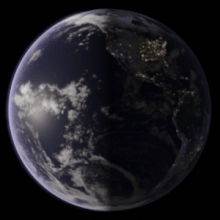
Image: Wikipedia
Earth rotating from West to East
Does Earth’s rotation affect a plane in flight?
The Earth is around 4.54 billion years old. It was formed when a cloud of gas collapsed due to gravity. As the cloud collapsed, it started to spin and continued to do so because there are no forces acting to stop it.
The circumference of the Earth at the Equator is about 24,000 miles (40,000 kilometres). It rotates once about every 24 hours. This is about 1000 miles per hour (mph) or twice the speed of an airliner at the Equator.
Having said that, we also know that the Earth rotates eastward. Let’s say we have one Boeing 777 flying at 550 mph westward from Kuala Lumpur to London. Logically, London would be moving towards the plane as the Earth spins at 1000 mph. The result would have been a super-fast flight!
In reality, that is not the case. This is because when the Earth spins, it takes all the air through which the plane flies in with it. Thanks to gravity.
Imagine you are on board the plane cruising at 550 mph towards London and you need to visit the washroom. There is one at 15 rows ahead of you and another one 15 rows behind.
Does it take you faster to walk to the washroom that is moving towards you at 550 mph or slower to move to the one moving away from you at 550 mph?
The answer is neither. It is the same because you are moving along at 550 mph with it. Hence, the Earth’s rotation does not affect a plane in flight.
This post also answers a question from Laurentius Hirfez, “Do planes spin with the Earth?”
In the above scenario, the wind is not taken into consideration. Normally, in the Northern Hemisphere in winter, there is always a strong headwind due to Jetstream that can increase the flight time to London.
Next, in view of the high spinning rate, why don’t we fly off the Earth?
Well, we are not thrown off because gravity is holding us down.
Further, because we are rotating with the Earth, a centrifugal force pushes us outward from the centre of the planet. If this centrifugal force were bigger than the force of gravity, then we would be thrown into space.
The strength of the centrifugal force depends on where you are. It is greatest at the Equator and zero at the Poles.
In order to overcome gravity, the Earth would need to spin approximately 17,000 mph to balance the gravitational force. This is known as the escape velocity at low orbit of 150 miles high or the minimum velocity by a rocket to escape from the earth’s gravity in order to fly into space.
To realize this, the Earth would have to spin once every 84 minutes to achieve that speed to throw human off into space. This is about 17 times faster than the normal spin speed and that is how rockets are launched.
Finally, does Earth’s rotation affect weight?
Yes, you would weigh less at the Equator than you would be at the Poles.
So, if a guy weighs 300 pounds in Quito, Ecuador which is 16 miles South of the Equator he would be almost 301 pounds at the South Pole.
See video on Why Isn’t It FASTER To Fly “West” If Earth Is SPINNING To The “East”?